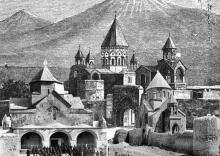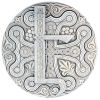In June 1804, Russian troops under the command of general Tsitsianov occupied the Ararat Plain in order to fight off the Erivan Fortress from the Persians. This was the first Erivan campaign of the Russian army. Trusting the generous promises of the Russians to help restore the Armenian sovereignty, the Armenians substantially supported the imperial troops.
Being cut off from their rear, the Russian army was in the need of food supplies, which the Armenian Church provided them with. Apart from that, Armenian volunteer units also supported the Russians, fighting in the forefront of Tsitsianov’s army.
At the approaches of Vagharshapat (Etchmiadzin) on June 30, 1804, the Russian army defeated the troops of Abbas Mirza, which allowed them to near Erivan. The besieging of the fortress would last from July 2 to September 2. Having failed to break through the Persians’ defense, Tsitsianov was forced to retreat to Tiflis. On their way, the Russian troops plundered the Mother Holy See of Holy Etchmiadzin.
The then Catholicos Daniel A Surmaretsi (1801 – 1808) wrote that the sight of the Russians plundering and crushing the Mother See was a strike to the heart. The Russians broke church doors, took apart the walls and floors in search for treasures and dusted the saint relics. They took not only gold and silver but also food, clothing, and household items. Catholicos wrote that the Russians left nothing to eat, to sit, and to sleep on.
Several days later, Fath-Ali Shah Qajar of Iran arrived in Etchmiadzin, perfectly aware of the sympathy towards the Russians among the majority of Armenians. In three days, Shah not only put the church in order but also exempted it from taxes due to the significant damage inflicted by the Russians.
Alas, this wasn’t the last time the Mother See was pillaged. After the conquest of Shirak in March 1805, major general Nesvetayev, a fateful successor of Tsitsianov, arrived in Etchmiadzin. Over the next few days, his soldiers discovered and looted the hiding places of the Mother See, carrying away precious stones, church utensils, robes of clergymen, and adornments, which was an unprecedented robbery of Mother See’s possessions.

